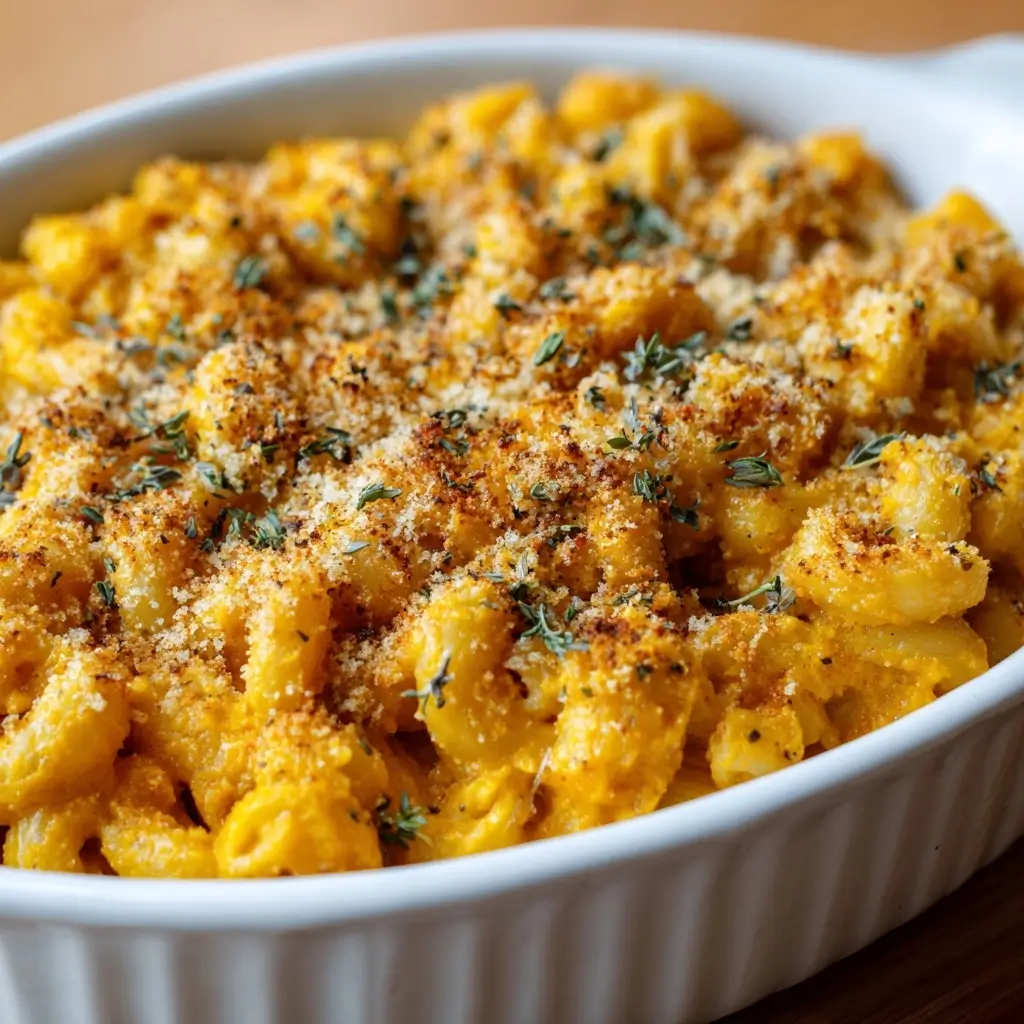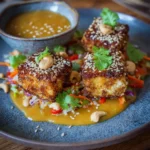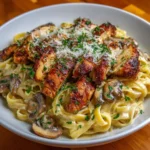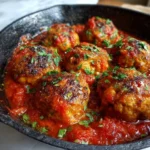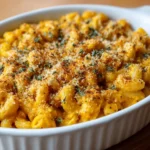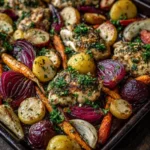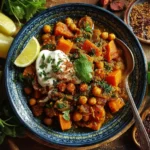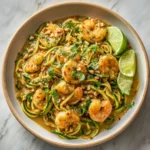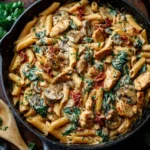Vegan Butternut Squash Mac & Cheese: A Creamy, Comforting Plant-Based Delight
There’s something undeniably comforting about a steaming bowl of mac and cheese—its creamy texture and rich flavor make it a favorite across generations. But what if you could enjoy that same indulgence without dairy, eggs, or animal products? Enter Vegan Butternut Squash Mac & Cheese, a lusciously smooth, nutrient-packed alternative that satisfies cravings while aligning with plant-based lifestyles. This dish transforms humble ingredients into a velvety sauce that clings perfectly to tender pasta, delivering a symphony of savory, sweet, and umami notes in every bite. Whether you’re vegan, lactose-intolerant, health-conscious, or simply looking to add more vegetables to your diet, this recipe is a must-try.
The History: From Classic Comfort to Plant-Powered Innovation
Macaroni and cheese has deep roots in Western culinary tradition, dating back to at least the 14th century in Italy, where pasta was baked with cheese and butter. The dish gained widespread popularity in the United States during the Great Depression, thanks to its affordability and heartiness. Over time, it became a staple of American comfort food, found in homes, school cafeterias, and gourmet restaurants alike.
As dietary preferences evolved and awareness around animal agriculture, health, and environmental sustainability grew, so did the demand for plant-based alternatives. The rise of veganism in the late 20th and early 21st centuries sparked innovation in dairy-free cooking. Chefs and home cooks began experimenting with cashews, potatoes, nutritional yeast, and root vegetables to replicate the creaminess and cheesiness of traditional sauces. Among these, butternut squash emerged as a star ingredient—not only for its natural sweetness and smooth texture when blended, but also for its vibrant color and nutritional benefits.
Vegan butternut squash mac and cheese represents the perfect fusion of nostalgia and modern wellness. It honors the essence of classic mac & cheese while reimagining it through a compassionate, health-forward lens. Today, variations of this dish grace vegan cookbooks, food blogs, and even restaurant menus, celebrated for their ability to convert even the most skeptical eaters.
Ingredients Breakdown: Why Each Component Matters
The magic of vegan butternut squash mac and cheese lies in its balance of flavor, texture, and nutrition. Let’s explore each ingredient and its role in creating this delectable dish:
- Butternut Squash – The star of the show. When roasted or boiled, butternut squash becomes silky smooth and slightly sweet, forming the base of the creamy sauce. Its high water content and natural starches help create a luxurious texture without needing dairy.
- Uncooked Elbow Macaroni (or Pasta of Choice) – Traditionally, elbow macaroni is used for its ability to hold sauce, but any short pasta like shells, penne, or rotini works. For a gluten-free option, use brown rice or chickpea pasta.
- Raw Cashews – Soaked and blended, cashews add richness, body, and a subtle nutty depth that mimics the fat content of cheese. They are essential for achieving a creamy consistency.
- Nutritional Yeast – Often called “nooch,” this deactivated yeast is a vegan staple. It imparts a cheesy, umami flavor due to its natural glutamates, enhancing savoriness without animal products.
- Garlic and Onion Powder – These aromatics deepen the flavor profile, adding warmth and complexity to the sauce.
- Dijon Mustard – A small amount introduces tanginess and brightness, balancing the sweetness of the squash and rounding out the flavor.
- Lemon Juice – Adds acidity, which lifts the entire dish and prevents the sauce from tasting flat or overly sweet.
- Smoked Paprika – Contributes a hint of smokiness, mimicking the depth found in aged cheeses.
- Salt and Black Pepper – Essential seasonings that enhance all other flavors.
- Plant-Based Milk – Unsweetened almond, oat, soy, or cashew milk helps adjust the sauce’s consistency and adds creaminess.
- Olive Oil (optional) – A drizzle can enrich the sauce and add a subtle fruitiness.
- Optional Toppings – Breadcrumbs (panko or regular), vegan parmesan, chopped parsley, roasted garlic, or sautéed mushrooms elevate texture and taste.
Step-by-Step Recipe: How to Make Vegan Butternut Squash Mac & Cheese
This recipe yields approximately 6 generous servings and takes about 45 minutes from start to finish.
Ingredients
- 1 medium butternut squash (about 2–2.5 lbs), peeled, seeded, and cubed
- 8 oz (225g) dry elbow macaroni (or preferred pasta)
- 1/2 cup raw cashews (soaked in hot water for 15–30 minutes)
- 3/4 cup unsweetened plant-based milk
- 1/4 cup nutritional yeast
- 1 tsp garlic powder
- 1/2 tsp onion powder
- 1 tbsp Dijon mustard
- 1 tbsp lemon juice
- 1/2 tsp smoked paprika
- 1/2 tsp sea salt (adjust to taste)
- 1/4 tsp black pepper
- 1–2 tbsp olive oil (optional)
- 1/2 cup vegan breadcrumbs (optional, for topping)
- Fresh parsley or chives, for garnish
Directions
- Prepare the Butternut Squash: Preheat your oven to 400°F (200°C). Place the cubed butternut squash on a baking sheet, toss with 1 tablespoon of olive oil (if using), and season lightly with salt and pepper. Roast for 25–30 minutes, or until fork-tender and slightly caramelized. Alternatively, you can boil the cubes in water for 15–20 minutes until soft. Drain well.
- Cook the Pasta: While the squash is roasting, bring a large pot of salted water to a boil. Add the pasta and cook according to package instructions until al dente. Drain, reserving about 1/2 cup of pasta water, and set aside.
- Soak the Cashews: Place raw cashews in a heatproof bowl and cover with boiling water. Let soak for at least 15 minutes (or up to 2 hours). This softens them for blending. Drain before using.
- Blend the Sauce: In a high-speed blender, combine the cooked butternut squash, soaked cashews, plant-based milk, nutritional yeast, garlic powder, onion powder, Dijon mustard, lemon juice, smoked paprika, salt, pepper, and olive oil (if using). Blend on high for 1–2 minutes, stopping to scrape down the sides as needed, until completely smooth and creamy. If the sauce is too thick, add a splash more plant milk or reserved pasta water to reach desired consistency.
- Combine Pasta and Sauce: Pour the blended sauce into the pot with the cooked pasta. Stir over low heat for 2–3 minutes until everything is heated through and well combined. Add reserved pasta water a tablespoon at a time if needed to loosen the sauce.
- Optional Baking Step: For a golden, slightly crispy top, transfer the mac and cheese to an oven-safe casserole dish. Sprinkle with vegan breadcrumbs and/or additional nutritional yeast. Bake at 375°F (190°C) for 15–20 minutes until bubbly and lightly browned.
- Serve: Garnish with fresh parsley or chives, cracked black pepper, and a sprinkle of smoked paprika or vegan parmesan. Serve warm.
Tips for Perfect Vegan Butternut Squash Mac & Cheese
- Use a High-Speed Blender: A powerful blender like a Vitamix or Blendtec ensures the sauce is silky smooth. Regular blenders may leave grittiness, especially from the cashews.
- Roast Instead of Boil: Roasting the squash enhances its natural sweetness and concentrates flavor better than boiling. It also reduces excess moisture, preventing a watery sauce.
- Don’t Skip the Soak: Soaking cashews is crucial for creaminess. If you’re short on time, use boiling water and let them sit for 15 minutes. For a nut-free version, replace cashews with 1/2 cup of cooked white beans or cauliflower.
- Adjust Seasonings: Taste the sauce before mixing with pasta. You may want more salt, lemon juice, or nutritional yeast depending on your preference.
- Avoid Overcooking Pasta: Al dente pasta holds up better when mixed with sauce and reheated later.
- Reheating Tips: Leftovers thicken in the fridge. Reheat gently on the stovetop with a splash of plant milk or water to restore creaminess.
- Make Ahead: Roast the squash and soak the cashews the night before to cut down prep time.
Variations and Customizations
This recipe is incredibly versatile—here are some creative ways to personalize your mac and cheese:
- Spicy Kick: Add 1/2 tsp cayenne pepper, a dash of hot sauce, or diced jalapeños to the sauce.
- Protein Boost: Stir in cooked lentils, crumbled tofu, tempeh bacon, or chickpeas.
- Greens Galore: Fold in sautéed spinach, kale, or broccoli florets for added nutrients and color.
- Extra Umami: Add 1 tsp miso paste or 1 tbsp tahini to deepen the savory flavor.
- Cheesy Variations: Mix in vegan cheddar shreds or a spoonful of cashew cheese for extra decadence.
- Herb-Infused: Stir in fresh thyme, rosemary, or sage for an aromatic twist.
- Gluten-Free: Use gluten-free pasta and ensure all other ingredients are certified GF.
- Nut-Free Version: Replace cashews with sunflower seeds or silken tofu, and use seed-based milk.
- Low-Fat Option: Omit cashews and olive oil; increase plant milk and use white beans for creaminess.
- Bold Color: Add a tablespoon of beet puree for a vibrant pink-hued mac and cheese (great for kids!).
Health Considerations and Nutritional Value
Vegan butternut squash mac and cheese isn’t just delicious—it’s packed with wholesome nutrients that support overall health.
Nutritional Highlights (per serving, approx. 1.5 cups):
- Calories: ~350–400 kcal
- Protein: 10–12g (from pasta, cashews, and nutritional yeast)
- Fat: 12–15g (mostly healthy unsaturated fats from cashews and olive oil)
- Carbohydrates: 55–60g (complex carbs from whole grains and squash)
- Fiber: 6–8g (supports digestion and satiety)
- Vitamin A: Over 200% DV (thanks to beta-carotene in butternut squash)
- Vitamin C: ~50% DV (immune support and antioxidant)
- B Vitamins: Especially B12 and folate (from nutritional yeast)
- Potassium & Magnesium: Important for heart and muscle function
Health Benefits:
- Rich in Antioxidants: Butternut squash contains carotenoids like alpha- and beta-carotene, which combat oxidative stress and support eye health.
- Supports Immunity: High vitamin C and zinc (from nutritional yeast) help maintain a strong immune system.
- Dairy-Free and Lactose-Free: Ideal for those with lactose intolerance or dairy allergies.
- Cholesterol-Free: Naturally free of cholesterol and low in saturated fat.
- Gut-Friendly: Fiber from squash and whole grain pasta promotes a healthy gut microbiome.
- Weight Management: Satiating and nutrient-dense, making it a satisfying meal without excessive calories.
Dietary Notes:
- Vegan & Plant-Based: No animal products used.
- Can Be Made Gluten-Free: With appropriate pasta substitution.
- Allergen Alert: Contains tree nuts (cashews); substitute as needed for nut allergies.
- Low-Sodium Option: Use low-sodium plant milk and reduce added salt.
Frequently Asked Questions (FAQ)
Q: Can I make this recipe without cashews?
A: Yes! Substitute with 1/2 cup cooked cannellini beans, silken tofu, or sunflower seeds for a nut-free version. The texture may be slightly less rich, but still creamy.
Q: Is butternut squash necessary, or can I use pumpkin?
A: Pumpkin (especially canned puree) works well as a substitute. Just ensure it’s unsweetened and unspiced. Acorn squash or sweet potato are also good alternatives.
Q: How long do leftovers last?
A: Store in an airtight container in the refrigerator for up to 5 days. Reheat with a splash of plant milk to restore creaminess.
Q: Can I freeze this mac and cheese?
A: Yes, though the texture may change slightly upon thawing. Freeze in portions for up to 3 months. Thaw in the fridge overnight and reheat gently on the stove.
Q: Why is my sauce gritty?
A: This usually happens if the cashews aren’t soaked long enough or if a low-powered blender is used. Always soak cashews and use a high-speed blender for best results.
Q: Can I use pre-cut butternut squash?
A: Absolutely! Many grocery stores sell pre-cubed squash, which can save prep time. Just roast or boil as directed.
Q: Is nutritional yeast safe for everyone?
A: Yes, for most people. It’s not the same as brewer’s yeast or active yeast, so it won’t affect candida or cause bloating in typical amounts. However, those with mold sensitivities should consult a doctor.
Q: How can I make this kid-friendly?
A: Serve with fun-shaped pasta, call it “orange dream pasta,” or mix in peas and carrots. The natural sweetness of squash often appeals to children.
Summary
Vegan Butternut Squash Mac & Cheese is a nourishing, flavorful twist on a classic comfort dish, combining creamy roasted squash, wholesome pasta, and a rich, cheesy sauce made entirely from plants. Packed with vitamins, fiber, and plant-based protein, it’s a guilt-free indulgence that delights vegans and non-vegans alike.
